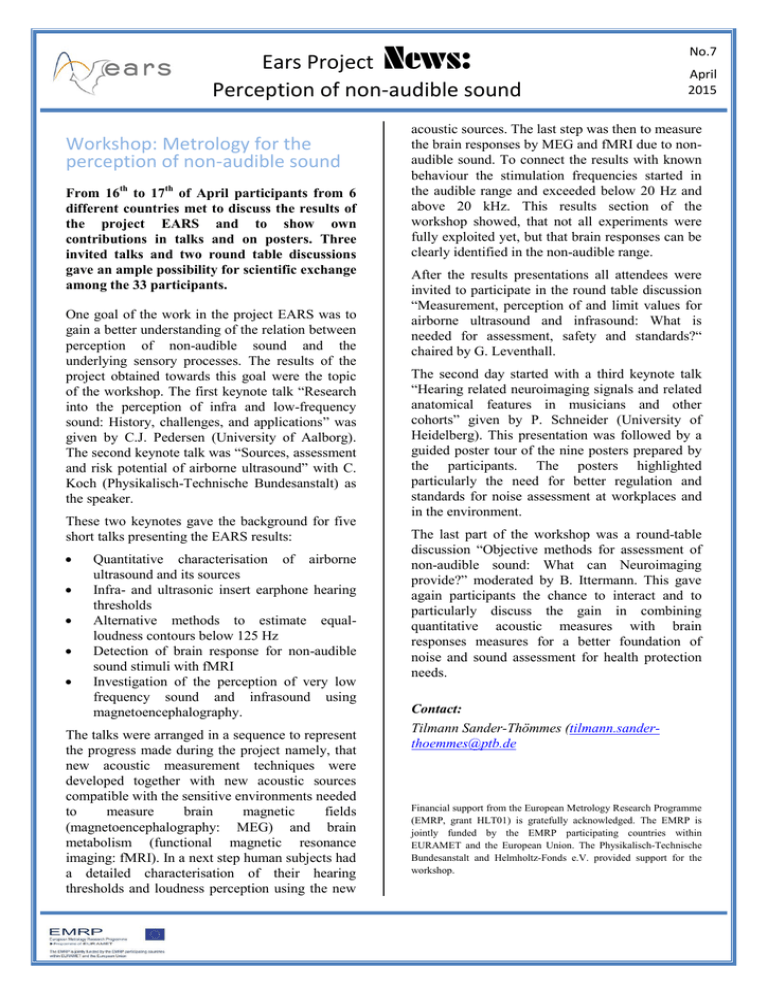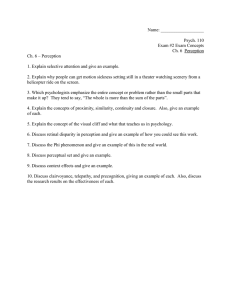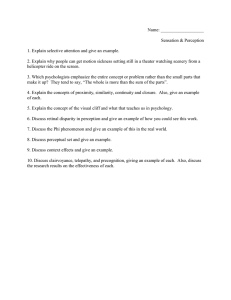Ears Project News: Perception of non
advertisement

Ears Project News: Perception of non-audible sound Workshop: Metrology for the perception of non-audible sound From 16th to 17th of April participants from 6 different countries met to discuss the results of the project EARS and to show own contributions in talks and on posters. Three invited talks and two round table discussions gave an ample possibility for scientific exchange among the 33 participants. One goal of the work in the project EARS was to gain a better understanding of the relation between perception of non-audible sound and the underlying sensory processes. The results of the project obtained towards this goal were the topic of the workshop. The first keynote talk “Research into the perception of infra and low-frequency sound: History, challenges, and applications” was given by C.J. Pedersen (University of Aalborg). The second keynote talk was “Sources, assessment and risk potential of airborne ultrasound” with C. Koch (Physikalisch-Technische Bundesanstalt) as the speaker. These two keynotes gave the background for five short talks presenting the EARS results: Quantitative characterisation of airborne ultrasound and its sources Infra- and ultrasonic insert earphone hearing thresholds Alternative methods to estimate equalloudness contours below 125 Hz Detection of brain response for non-audible sound stimuli with fMRI Investigation of the perception of very low frequency sound and infrasound using magnetoencephalography. The talks were arranged in a sequence to represent the progress made during the project namely, that new acoustic measurement techniques were developed together with new acoustic sources compatible with the sensitive environments needed to measure brain magnetic fields (magnetoencephalography: MEG) and brain metabolism (functional magnetic resonance imaging: fMRI). In a next step human subjects had a detailed characterisation of their hearing thresholds and loudness perception using the new No.7 April 2015 acoustic sources. The last step was then to measure the brain responses by MEG and fMRI due to nonaudible sound. To connect the results with known behaviour the stimulation frequencies started in the audible range and exceeded below 20 Hz and above 20 kHz. This results section of the workshop showed, that not all experiments were fully exploited yet, but that brain responses can be clearly identified in the non-audible range. After the results presentations all attendees were invited to participate in the round table discussion “Measurement, perception of and limit values for airborne ultrasound and infrasound: What is needed for assessment, safety and standards?“ chaired by G. Leventhall. The second day started with a third keynote talk “Hearing related neuroimaging signals and related anatomical features in musicians and other cohorts” given by P. Schneider (University of Heidelberg). This presentation was followed by a guided poster tour of the nine posters prepared by the participants. The posters highlighted particularly the need for better regulation and standards for noise assessment at workplaces and in the environment. The last part of the workshop was a round-table discussion “Objective methods for assessment of non-audible sound: What can Neuroimaging provide?” moderated by B. Ittermann. This gave again participants the chance to interact and to particularly discuss the gain in combining quantitative acoustic measures with brain responses measures for a better foundation of noise and sound assessment for health protection needs. Contact: Tilmann Sander-Thömmes (tilmann.sanderthoemmes@ptb.de Financial support from the European Metrology Research Programme (EMRP, grant HLT01) is gratefully acknowledged. The EMRP is jointly funded by the EMRP participating countries within EURAMET and the European Union. The Physikalisch-Technische Bundesanstalt and Helmholtz-Fonds e.V. provided support for the workshop.





